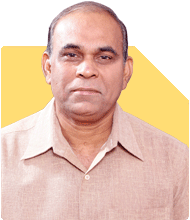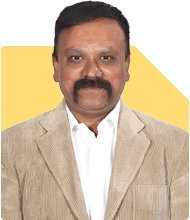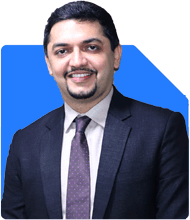Will my savings be enough for retirement?
Ramalingam Kalirajan |10872 Answers |Ask -Follow
Mutual Funds, Financial Planning Expert - Answered on Aug 21, 2024
He has an MBA in finance from the University of Madras and is a certified financial planner.
He is the director and chief financial planner at Holistic Investment, a Chennai-based firm that offers financial planning and wealth management advice.... more
.jpg)
Sir,I m 43 year old, working in pvt college and getting 60000per month,pls elaborate me about investing and savings for my retirement and present expenses as I have two kids one is 16year and another one is 12 year
Managing Current Expenses
You have two children, aged 16 and 12, and it’s vital to manage your monthly expenses carefully. A clear budget is the foundation of good financial planning.
Household Expenses: Ensure your essential expenses are well-covered. These include food, utilities, and other daily necessities. Try to allocate a specific amount each month to prevent overspending.
Children’s Education: With children at 16 and 12 years old, educational expenses will increase, especially as your older child approaches higher education. Plan for tuition fees, books, and other related costs.
Emergency Fund: Maintain an emergency fund equivalent to at least six months of your monthly income. This fund will protect you from unexpected financial burdens like medical emergencies or job loss.
Allocating Savings for Future Needs
Balancing current expenses with savings for future needs is key to long-term financial security. Let’s explore how you can start saving efficiently.
Retirement Planning: You’re currently 43 years old, so retirement is still some years away. However, starting early is important. Consider contributing 20-30% of your income towards retirement savings. Look for options that offer a balance between growth and safety.
Children’s Higher Education: Higher education can be costly. Start investing in a dedicated plan for your children’s education. This should be separate from your retirement savings to avoid depleting your retirement funds.
Investment Options for a Secure Future
With a stable income, it’s crucial to explore the right investment options to grow your wealth. A diversified approach is recommended, keeping in mind your risk tolerance and time horizon.
Diversified Mutual Funds
Balanced Growth: Diversified mutual funds offer a mix of equity and debt, balancing risk and reward. This type of fund is ideal if you’re looking for moderate growth without exposing your investments to excessive risk.
Professional Management: Actively managed mutual funds are handled by professional fund managers who adjust the portfolio based on market conditions. This offers you peace of mind, knowing that experts are managing your investments.
Regular Savings: Systematic Investment Plans (SIPs) allow you to invest small amounts regularly. SIPs help in averaging out market volatility and building wealth over time.
Disadvantages of Index Funds and Direct Funds
You might come across index funds or direct funds as investment options. While they may seem appealing due to lower fees, they come with certain disadvantages.
Index Funds: These funds passively track an index and do not try to outperform the market. While fees are lower, they may not provide the returns you need, especially during market downturns. The lack of active management could result in missed opportunities.
Direct Funds: Direct funds cut out the intermediary, saving on commission fees. However, this approach requires you to manage and monitor your investments closely. It’s easy to make mistakes without expert guidance. Regular funds, on the other hand, offer the benefit of advice from a Certified Financial Planner, who can help optimize your investments.
Tax-Efficient Investments
Tax efficiency is a critical aspect of your financial plan. Choosing investments that offer tax benefits can maximize your returns.
Tax-Saving Instruments: Look into options that provide deductions under Section 80C, such as Public Provident Fund (PPF) or certain life insurance plans. These not only help in saving taxes but also ensure a safe return on your investment.
Long-Term Capital Gains: Consider investments that are taxed as long-term capital gains (LTCG) after a holding period. LTCG tax rates are generally lower than income tax rates, making them a tax-efficient option for wealth growth.
Insurance: Protecting Your Family’s Future
Insurance is an essential part of financial planning. It ensures that your family is financially protected in case of any unforeseen events.
Life Insurance: If you haven’t already, consider purchasing a term life insurance plan. This type of insurance provides a high coverage amount at a lower premium, ensuring your family’s financial security if something happens to you.
Health Insurance: With increasing healthcare costs, it’s important to have a comprehensive health insurance policy. This should cover you and your family, including any critical illness riders if possible.
Evaluating Your Retirement Corpus
When planning for retirement, it’s important to estimate the corpus you’ll need. The amount should be sufficient to cover your living expenses without relying on others.
Inflation: Consider inflation when planning your retirement corpus. The cost of living will increase over time, so your savings should be able to provide you with a comfortable lifestyle even 20-30 years from now.
Pension Options: If your employer offers a pension plan, review the benefits. If not, consider setting up a self-managed retirement plan that includes a mix of investments and savings.
Creating a Long-Term Investment Plan
A long-term investment plan is necessary to ensure that your savings grow steadily. This plan should include a mix of short-term and long-term investments, catering to different financial goals.
Equity Exposure: With 15-20 years until retirement, you can afford to have some exposure to equity investments. Equities have the potential to deliver higher returns over the long term, though they come with higher risks.
Debt Instruments: Complement your equity investments with safer debt instruments like bonds or fixed deposits. This will balance your portfolio and provide a steady income stream with lower risk.
Regular Review and Adjustment
A financial plan is not a one-time activity. Regularly reviewing and adjusting your plan is crucial to keep up with changes in your life and in the market.
Annual Review: Set aside time each year to review your financial plan. Assess whether your investments are performing as expected and whether you need to make any changes.
Goal Adjustment: As your children grow older and your financial situation changes, you may need to adjust your goals. Ensure your plan remains aligned with your evolving needs.
Final Insights
Balancing current expenses with future savings is a delicate task, but it’s entirely achievable with a disciplined approach. Prioritizing your children’s education, creating a solid retirement plan, and choosing tax-efficient, diversified investments will help you build a secure financial future. Regular reviews and adjustments to your plan will ensure you stay on track to meet your goals.
Best Regards,
K. Ramalingam, MBA, CFP,
Chief Financial Planner,
www.holisticinvestment.in
You may like to see similar questions and answers below
Ramalingam Kalirajan |10872 Answers |Ask -Follow
Mutual Funds, Financial Planning Expert - Answered on Jun 23, 2024
Ramalingam Kalirajan |10872 Answers |Ask -Follow
Mutual Funds, Financial Planning Expert - Answered on Jun 30, 2024
Ramalingam Kalirajan |10872 Answers |Ask -Follow
Mutual Funds, Financial Planning Expert - Answered on Jul 04, 2024
Ramalingam Kalirajan |10872 Answers |Ask -Follow
Mutual Funds, Financial Planning Expert - Answered on Jul 07, 2025
Ramalingam Kalirajan |10872 Answers |Ask -Follow
Mutual Funds, Financial Planning Expert - Answered on Jul 30, 2025
Radheshyam Zanwar |6735 Answers |Ask -Follow
MHT-CET, IIT-JEE, NEET-UG Expert - Answered on Dec 06, 2025
Dr Nagarajan J S K |2576 Answers |Ask -Follow
NEET, Medical, Pharmacy Careers - Answered on Dec 06, 2025
Mihir Tanna |1090 Answers |Ask -Follow
Tax Expert - Answered on Dec 06, 2025
Ramalingam Kalirajan |10872 Answers |Ask -Follow
Mutual Funds, Financial Planning Expert - Answered on Dec 06, 2025
Radheshyam Zanwar |6735 Answers |Ask -Follow
MHT-CET, IIT-JEE, NEET-UG Expert - Answered on Dec 06, 2025
Radheshyam Zanwar |6735 Answers |Ask -Follow
MHT-CET, IIT-JEE, NEET-UG Expert - Answered on Dec 06, 2025
Radheshyam Zanwar |6735 Answers |Ask -Follow
MHT-CET, IIT-JEE, NEET-UG Expert - Answered on Dec 06, 2025
Dr Dipankar Dutta |1837 Answers |Ask -Follow
Tech Careers and Skill Development Expert - Answered on Dec 05, 2025
Dr Shyam Jamalabad |108 Answers |Ask -Follow
Dentist - Answered on Dec 05, 2025
Dr Shyam Jamalabad |108 Answers |Ask -Follow
Dentist - Answered on Dec 05, 2025

























